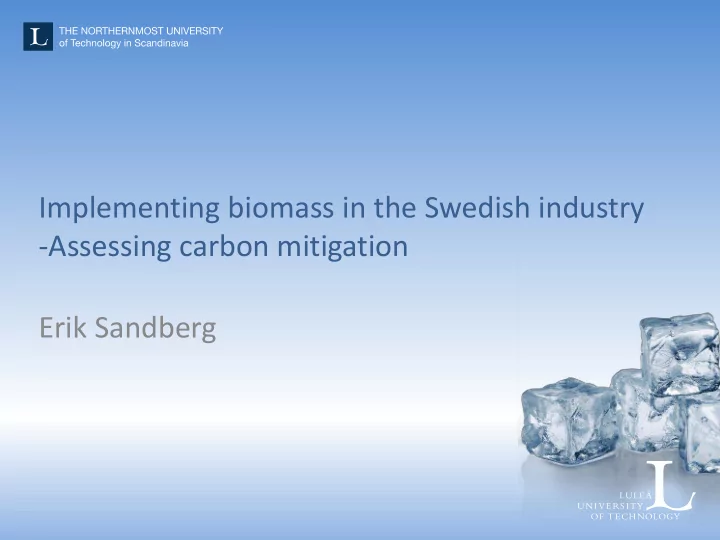

Implementing biomass in the Swedish industry -Assessing carbon mitigation Erik Sandberg
2 What is this about? How much biomass is required in different industrial carbon mitigation options? – Bio based fuel substitution might not be the best use of biomass – CCS might be the most efficient use of biomass
3 Workflow Mapping the energy use of the industry Identify fuel substitution possibilities and alternative technologies Scenario creation and analysis
4 Mapped energy use 2013 NFM FAT OI MAQ PPI CHE NMM IIS 0 10 20 30 40 50 60 70 80 TWh Biomass Electricity Gas Solid fossil fuels Total petroleum products Waste Statistic data – Final consumption 2013 – Eurostat & Statistic Sweden
5 Mapped energy use 2013 Energy intensive industries – Energy use allocated to industrial activities Non energy intensive industries – Energy use allocated to industrial heat demands
6 Mapped CO2 emissions NFM FAT OI MAQ PPI CHE NMM IIS 0 10 20 30 40 50 60 100 kton Gas Process emissions Solid fossil fuels Total petroleum products Waste – Calculated values based on energy use
7 The Options Fuel substitution or… …alternative technologies
8 Bio based fuel substitution – Biomass Default substitution for low and medium heat demands Used for high heat demands if proven possible – Biofuel (SNG) Used as substitute for natural gas, fuel oil and LPG (if natural gas is listed as a fuel option in current technologies) – Biofuel (Charcoal/torrefied) Used as substitute for solid fossil fuels where proven possible
9 Bio based fuel substitution Large possibility of fuel substitution Not in IIS and NFM Industrial Application Potential biomass sector area/industry substitution IIS Blast furnace: Coke, PCI 20% Biofuels, 100% Biofuels Heating ovens 100% Biofuels MAQ Pelletization process 100% Biomass/Biofuels NFM Copper and lead etc. 100% Biofuels/Biomass Primary aluminium 0% Secondary aluminium 100% Biofuels Foundries 100% Biofuels NMM Cement 100% Biofuels Lime 100% Biomass /Biofuels Glass & mineral wool 100% Biofuels Ceramics 100% Biofuels PPI Limekiln 100% Biomass FAT Heating purposes 100% Biomass OI Heating purposes 100% Biomass CHE n/a n/a
10 Alternative technologies Alternative technologies – Alternative technologies using biomass – CCS Electrical alternatives – The electrical alternatives proven available Uncertain alternatives – Technologies that are not proven available
11 Alternative technologies Indust Application Alternative Electrical Uncertain alternatives rial area/industry technologies alternatives sector IIS Blast furnace: Coke, PCI PCC CCS, Bio-DRI Hydrogen-DRI Electro winning Heating ovens n/a Possible n/a MAQ Pelletization process n/a n/a Electro thermal NFM Copper and lead etc. n/a n/a n/a Primary aluminium CCS n/a Inert anodes Secondary aluminium n/a Possible n/a Foundries n/a Possible n/a NMM Cement CCS n/a Electro thermal, Oxyfuel CCS Lime CCS n/a Electro thermal, Oxyfuel CCS Glass & mineral wool n/a Possible n/a Ceramics n/a Possible n/a PPI Limekiln n/a n/a Electro thermal FAT Heating purposes n/a Heat pumps Heat pumps OI Heating purposes n/a Heat pumps Heat pumps CHE n/a Change of input, new n/a n/a base chemicals etc.
12 Scenario analysis Answer to the question … … with different technology setups.
13 Scenario analysis Bio substitution +/- CCS Bio sub. + Alternative technologies +/- CCS Bio sub. + Electrical alternatives +/- CCS Bio sub. + Uncertain alternatives +/- CCS
14 Scenario results Present consumption Bio. Sub. Bio. Sub.+CCS CO2 emissions Alt. Tech. Alt. Tech.+CCS El. Sub. El. Sub.+CCS Tot. Elec. Tot. Elec.+CCS Present consumption Bio. Sub. Bio. Sub.+CCS Energy use Alt. Tech. Alt. Tech.+CCS El. Sub. El. Sub.+CCS Tot. Elec. Tot. Elec.+CCS 0 20 40 60 80 100 120 140 Energy(TWh) / CO2 emissions(100 kton) Biofuel(l/g) Biofuel(s) Biofuel(trans) Biomass Electricity Gas Process emissions Solid fossil fuels Total petroleum products Waste
15 Scenario results Alt. Feedstock (low) Alt. Feedstock (medium) Alt. Feedstock (high) Add. Prim. Biomass Bio. Sub. Bio. Sub.+CCS Alt. Tech. Alt. Tech.+CCS El. Sub. El. Sub.+CCS Tot. Elec. Tot. Elec.+CCS Bio. Sub. Bio. Sub.+CCS Add. Electricity Alt. Tech. Alt. Tech.+CCS El. Sub. El. Sub.+CCS Tot. Elec. Tot. Elec.+CCS 0 10 20 30 40 50 60 70 80 Energy(TWh) Biofuel(l/g) Biofuel(s) Biofuel(trans) Biomass Electricity
16 Scenario results Alt. Feedstock (low) Alt. Feedstock (medium) Alt. Feedstock (high) Add. Prim. Biomass Bio. Sub. Bio. Sub.+CCS Alt. Tech. Alt. Tech.+CCS El. Sub. El. Sub.+CCS Tot. Elec. Tot. Elec.+CCS Bio. Sub. Bio. Sub.+CCS Add. Electricity Alt. Tech. Alt. Tech.+CCS El. Sub. El. Sub.+CCS Tot. Elec. Tot. Elec.+CCS 0 10 20 30 40 50 60 70 80 Energy(TWh) Biofuel(l/g) Biofuel(s) Biofuel(trans) Biomass Electricity
17 Scenario results Alt. Feedstock (low) Alt. Feedstock (medium) Alt. Feedstock (high) Add. Prim. Biomass Bio. Sub. Bio. Sub.+CCS Alt. Tech. Alt. Tech.+CCS El. Sub. El. Sub.+CCS Tot. Elec. Tot. Elec.+CCS Bio. Sub. Bio. Sub.+CCS Add. Electricity Alt. Tech. Alt. Tech.+CCS El. Sub. El. Sub.+CCS Tot. Elec. Tot. Elec.+CCS 0 10 20 30 40 50 60 70 80 Energy(TWh) Biofuel(l/g) Biofuel(s) Biofuel(trans) Biomass Electricity
18 Scenario performance 60 6 50 5 40 4 30 3 20 2 10 1 0 0 -10 -1 -20 -2 Bio. Sub. Bio. Alt. Tech. Alt. El. Sub. El. Tot. Elec. Tot. Sub.+CCS Tech.+CCS Sub.+CCS Elec.+CCS Add. Biomass Add. Electricity. Biomass Electricity Total energy
19 Conclusions • 12-34 TWh of biomass required to achive carbon neutrality • CCS the most efficient way of utilizing biomass for emission reduction purposes, bio based fuel substitution most innefficient if used as the only option • CCS required to reach carbon neutrality
20 Thank you!
Recommend
More recommend